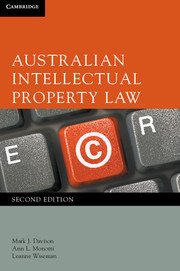Book contents
- Frontmatter
- Contents
- Preface
- Acknowledgements
- Table of statutes
- Table of cases
- 1 Introduction
- 2 Passing off
- 3 Registered trade marks
- 4 Exploitation of registered trade marks
- 5 Copyright: introduction
- 6 Subsistence of copyright
- 7 Authorship and first ownership, nature of the rights and duration
- 8 Exploitation, infringement and defences
- 9 Moral rights, performers’ rights, artist's resale rights, and other rights
- 10 Designs
- 11 Equitable doctrine of breach of confidence
- 12 Patents for inventions: introduction
- 13 Patents for inventions: validity
- 14 Patents for inventions: allocation of rights and ownership, the Register and dealings
- 15 Patents for inventions: exploitation, infringement and revocation
- 16 Plant breeder's rights
- 17 Remedies and miscellaneous issues
- Index
- References
15 - Patents for inventions: exploitation, infringement and revocation
- Frontmatter
- Contents
- Preface
- Acknowledgements
- Table of statutes
- Table of cases
- 1 Introduction
- 2 Passing off
- 3 Registered trade marks
- 4 Exploitation of registered trade marks
- 5 Copyright: introduction
- 6 Subsistence of copyright
- 7 Authorship and first ownership, nature of the rights and duration
- 8 Exploitation, infringement and defences
- 9 Moral rights, performers’ rights, artist's resale rights, and other rights
- 10 Designs
- 11 Equitable doctrine of breach of confidence
- 12 Patents for inventions: introduction
- 13 Patents for inventions: validity
- 14 Patents for inventions: allocation of rights and ownership, the Register and dealings
- 15 Patents for inventions: exploitation, infringement and revocation
- 16 Plant breeder's rights
- 17 Remedies and miscellaneous issues
- Index
- References
Summary
The role of the patent specification
A patent specification is a public instrument which contains the patentee's unilateral statement to the public of what are claimed as the essential features (integers) of the invention. The grant of the monopoly rights in a patent are balanced by the disclosure of the invention to the public.
As a patent specification is directed to a person skilled in the art to which the specification relates, it can contain less detail than would be necessary if it were directed to a person not skilled in the relevant way. The patent specification itself is made up of several parts which have different functions. The body, apart from the preamble, is there to instruct those skilled in the art concerned in the carrying out of the invention. The claims identify the legal limits of the monopoly granted by the patent and must define the invention in a way that is not reasonably capable of being misunderstood. Inadvertent or deliberate omissions from the claim have no protection. In other words, what is not claimed is disclaimed.
Information
- Type
- Chapter
- Information
- Australian Intellectual Property Law , pp. 549 - 596Publisher: Cambridge University PressPrint publication year: 2011
